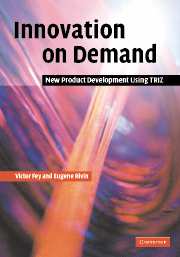Book contents
- Frontmatter
- Contents
- Preface
- 1 Introduction
- 2 Resolving system conflicts
- 3 Basics of the substance–field analysis
- 4 Algorithm for inventive problem solving (ARIZ)
- 5 Laws of technological system evolution
- 6 Guiding technology evolution
- Appendix 1 Genrikh Altshuller – the creator of TRIZ
- Appendix 2 System conflict matrix and inventive principles
- Appendix 3 Standard approaches to solving inventive problems
- Appendix 4 Using TRIZ in management practice
- Appendix 5 Glossary
- References
- Index
Appendix 5 - Glossary
Published online by Cambridge University Press: 14 January 2010
- Frontmatter
- Contents
- Preface
- 1 Introduction
- 2 Resolving system conflicts
- 3 Basics of the substance–field analysis
- 4 Algorithm for inventive problem solving (ARIZ)
- 5 Laws of technological system evolution
- 6 Guiding technology evolution
- Appendix 1 Genrikh Altshuller – the creator of TRIZ
- Appendix 2 System conflict matrix and inventive principles
- Appendix 3 Standard approaches to solving inventive problems
- Appendix 4 Using TRIZ in management practice
- Appendix 5 Glossary
- References
- Index
Summary
Algorithm for inventive problem solving, ARIZ
The central analytical tool of TRIZ (ARIZ is a Russian abbreviation). Its basis is a sequence of logical procedures to analyze a vague or ill-defined initial problem/situation and transform it into a distinct system conflict. Consideration of the system conflict leads to the formulation of a physical contradiction whose elimination is provided with the help of the separation principles, and by the maximal utilization of the resources of the subject system. ARIZ is a system of the most fundamental concepts and methods of TRIZ, such as ideal technological system (ideal system), system conflict, physical contradiction, the sufield analysis, the Standards, and the laws of technological system evolution.
Altshuller's metrics
See Technology assessment curves.
Auxiliary function
A function supporting the system's primary function.
Auxiliary tool
A tool supporting the performance of the main tool(s). Particularly, auxiliary tools perform the function of measurement and/or detection in a system whose primary function is not measurement or detection.
Bi-system
A system consisting of two mono-systems.
Chain sufield
A sufield in which S2 is controlled by another substance, S3 (see Chapter 3, Table 3.3).
Coefficient of convolution, Cc
A measure of the system's degree of ideality; the ratio of the number of sufields to the number of elements these sufields contain (or the ratio of the number of functions to the number of sufield elements involved in the performance of these functions). For an elementary sufield, Cc = 1/3; for a chain sufield, Cc = 2∕5; for a double sufield, Cc = 1∕2.
Completely convoluted bi- or poly-system
A completely integrated bi- or poly-system performing two or more functions. In such systems, sub-systems responsible for individual functions are often merged into one substance; their separation is impossible without disintegrating the whole system (e.g., in photochromic reading glasses, two functions – eyesight enhancement and shielding sun light – are performed by one substance – the lens material).
- Type
- Chapter
- Information
- Innovation on DemandNew Product Development Using TRIZ, pp. 229 - 236Publisher: Cambridge University PressPrint publication year: 2005

